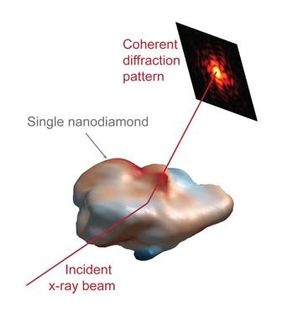New diamond structures produce bright luminescence
Use in quantum cryotography and biomarkers applications
germanium defects in a diamond crystal lattice act as a reliable source for single photons, new research shows. The results provide a promising new route to building components for quantum cryptography and biomarkers.
Pure diamonds are naturally colorless, but gaps in the crystal structure or impurities of other elements can create colors and even emit fluorescence. Recently, researchers have shown that the fluorescent lattice defects could be useful as single photon sources for quantum cryptography and as bright luminescent makers in living cells.
Now, Takayuki Iwasaki and co-workers at Tokyo Institute of Technology (Tokyo Tech), together with scientists across Japan and Germany, have demonstrated a new type of diamond crystal defect that fluoresces to produce single photons in a narrow, high energy wavelength band. The defects, which have been named germanium-vacancy (GeV) centres, are relatively easy to fabricate in a reliable, reproducible way.
Iwasaki and co-workers were inspired by recent work that demonstrated fluorescence from nitrogen-vacancy (NV) and silicon-vacancy (SiV) defects in diamond. They used an ion implantation method to insert germanium atoms into diamond films, before heating the films at 800 ⁰C. The resulting samples showed fluorescence only after heating, which induces diffusion of vacancies in the diamond lattice. The researchers therefore concluded that the fluorescence was produced by combined defects, each comprising a germanium atom side-by-side with a vacancy.
The GeV centres produced single-photon bursts of fluorescence centred at a wavelength of around 602 nm, representing a higher energy fluorescence than SiV centres. Moreover, the researchers were also able to create the films through the less destructive method of chemical vapor deposition, producing films with narrower and more stable emission peaks of ensemble GeV centres which are useful for biomarkers.
Original publication
Takayuki Iwasaki, Fumitaka Ishibashi, Yoshiyuki Miyamoto, Yuki Doi, Satoshi Kobayashi, Takehide Miyazaki, Kosuke Tahara, Kay D. Jahnke, Lachlan J. Rogers, Boris Naydenov, Fedor Jelezko, Satoshi Yamasaki, Shinji Nagamachi, Toshiro Inubushi, Norikazu Mizuochi and Mutsuko Hatano; "Germanium-Vacancy Single Color Centers in Diamond"; Scientific Reports; 2015
Most read news
Original publication
Takayuki Iwasaki, Fumitaka Ishibashi, Yoshiyuki Miyamoto, Yuki Doi, Satoshi Kobayashi, Takehide Miyazaki, Kosuke Tahara, Kay D. Jahnke, Lachlan J. Rogers, Boris Naydenov, Fedor Jelezko, Satoshi Yamasaki, Shinji Nagamachi, Toshiro Inubushi, Norikazu Mizuochi and Mutsuko Hatano; "Germanium-Vacancy Single Color Centers in Diamond"; Scientific Reports; 2015
Organizations
Other news from the department science

Get the chemical industry in your inbox
From now on, don't miss a thing: Our newsletter for the chemical industry, analytics, lab technology and process engineering brings you up to date every Tuesday and Thursday. The latest industry news, product highlights and innovations - compact and easy to understand in your inbox. Researched by us so you don't have to.





























































